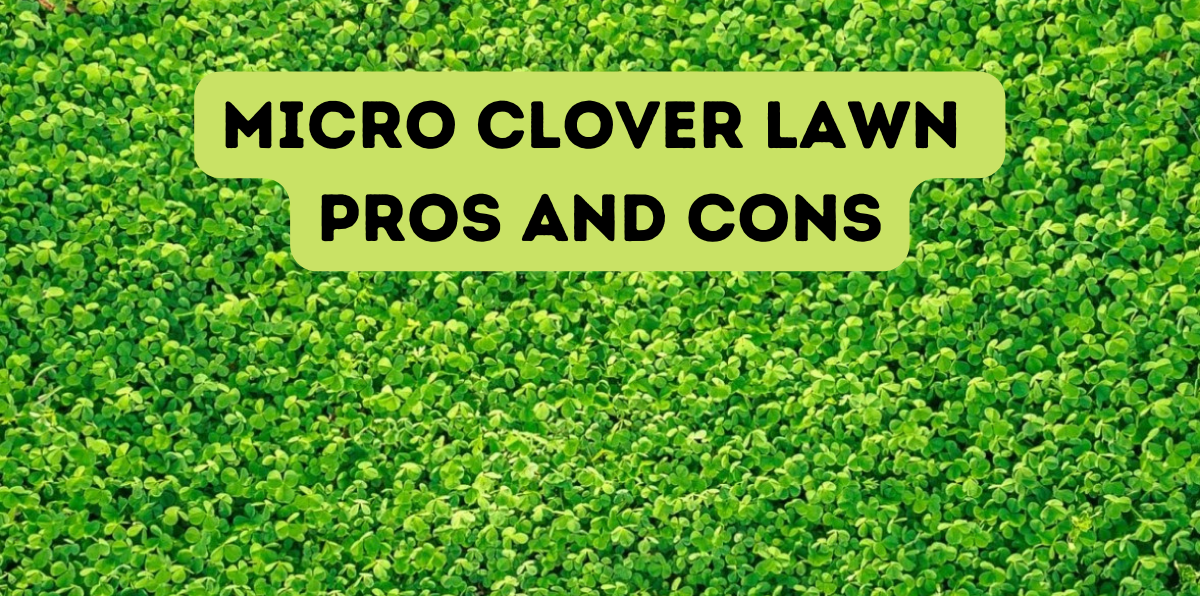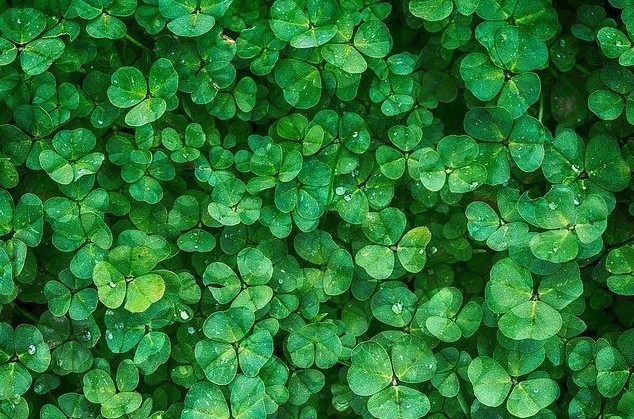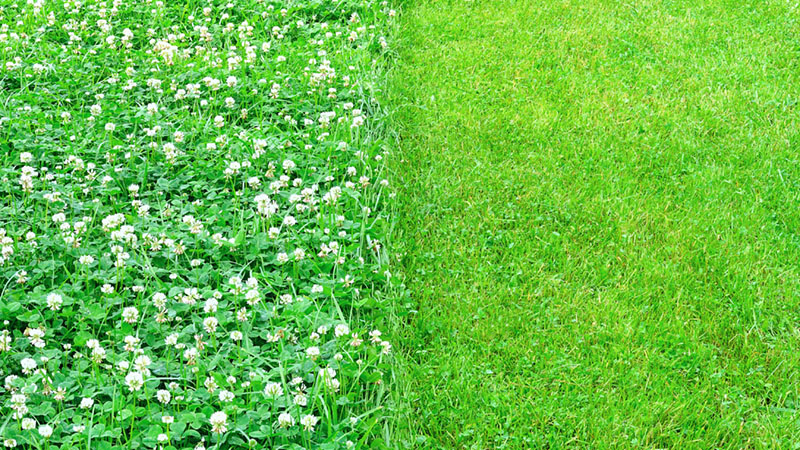
People across North America are replacing their grass lawns with low-maintenance plants that are easier to maintain. It is necessary to cut your grass regularly, but it is also necessary to fertilize, aerate, de-thatch, and water your lawn in order to keep it lush and green all year round. In addition, some people resort to using herbicides to rid their lawns of dandelions.
Clover is an example of a low-maintenance plant that also benefits local pollinators. It is also drought-resistant and requires little to no fertilizer. A grass lawn is an ultimate goal for many people, but it is difficult to persuade those who believe otherwise. A list of micro clover lawn pros and cons can assist anyone in determining whether or not this is the best option for them. There’s a lot of confusion about the difference between clover and micro clover, so let’s get that out of the way first.
What is Micro Clover?

White clover (Trifolium repens) has been bred in Europe for decades as a miniature variety known as micro clover (Trifolium microphyllum). Shorter than standard Dutch white clover, it can be used to create a mixed or pure clover lawn.
Even if you don’t mow it, micro clover, a diminutive form of white clover, doesn’t grow much higher than 6 inches (1). It can grow up to 4 inches tall if it is mowed on a regular basis. Even if you mow your lawn, the leaves of micro clover will regrow even smaller than they were before! White clover, on the other hand, doesn’t bloom nearly as often or frequently as this variety.
Pipolina is the most common variety of micro clover in North America. Buying micro clover online appears to be the best option because it is more difficult to locate in local garden centers.
That doesn’t mean you can’t grow a pure micro clover lawn despite the fact that micro clover was designed for mixed grass/clover purposes. Indeed, a micro clover-only lawn has been successfully implemented by a number of people.
Micro Clover Lawn Pros and Cons

Researching your options is essential before beginning a project. Therefore, I have compiled my findings in order to save you the trouble of doing research on micro clover lawns. It turns out that micro clover is a more sustainable and environmentally-friendly choice than grass. This is especially true in light of the recent spate of droughts, and I wouldn’t be surprised if everyone began using micro clover as a result of this development.
The following are some of the benefits and drawbacks of having a micro clover lawn.
Why Micro Clover Lawns Are Better Than Grass
Is it better to have a micro clover lawn or a grass lawn? After reading the long list of advantages, you’ll be able to make up your own mind (compared to the tiny list of cons). Let’s begin with the fact that clover is a nitrogen fixer in the soil, which is critical to the growth of other plants in the area.
1. Nitrogen Fixer: It is true that clovers are legumes, which are beneficial to the health and fertility of the soil. Clover acts as a natural fertilizer because it draws nitrogen compounds from the atmosphere and returns them to the soil. As a result of this nitrogen-fixing feature, clover-rich grass will be healthier and greener.
2. Less Fertilizer: Clover doesn’t need to be fertilized because it fixes nitrogen. It’s a self-fertilizer, too!
3. Drought Resistant: Dry conditions are no match for the deep root system of micro clover, which keeps its green color even when the rest of the lawn turns brown. During the hottest months of the year, when the rest of your lawn is turning brown, Clover will remain green. When the weather is warming up, it also begins to turn a beautiful shade of green.
4. No Mowing: When it comes to mowing micro clover, you don’t have to do it as frequently as a grass lawn. Micro clover will grow to a height of 6 inches if left uncut, and 4 inches if mowed on a regular basis.
5. No Aerating: For clover to remain lush and green, it doesn’t need to be regularly aerated (unlike grass lawns). Clover is more tolerant of compacted soil than grasses, and it actually helps to reduce compaction (therefore, aerating is kind of pointless). You’ll save money by not having to pay a lawn care company to aerate your lawn.
6. No Herbicide: To kill clover, use a herbicide that targets broad-leaf plants. As a result, there will be less chemical toxicity in your home and better environmental health.
7. Ground Cover: Clover is an excellent lawn filler for dead or underdeveloped areas of the lawn. It’s also a great choice for planting between paving stones because it’s both beautiful and functional.
8. Beneficial for Pollinators and Wildlife: Clover’s nectar-rich flowers are a major source of nectar for pollinating insects, such as bees. Cute little white flowers will appear if you don’t mow your clover very often, and they’ll be beneficial to insects as well. Insect pollinators, such as bees, will benefit from increased nectar availability if it is made more readily available to them.
9. Repels Pests and Weeds: Insect pests prefer grasses, so clover can help keep them at bay. As an added bonus, it can even kill weeds like dandelion, even though they are an excellent source of medicine.
10. Sun or Shade: In both sun and shade, clover thrives. Though it will grow more slowly than the rest of the lawn, the shady areas will not suffer as badly as grass does when they are not given enough light.
11. Dogs Can Pee on It: There are no “dog patches” on the lawn because clover is resistant to the urea produced by dog urine. Clover lawns, on the other hand, remain lush and green even after being sprayed with dog pee.
Why Some People Might Not Want Clover Lawns
A micro clover lawn has many advantages that outweigh the drawbacks. However, there are a few reasons why a full clover lawn may not be desired:
- It’s easier to stain clothes with clover than it is with grass. For regular white clover, not micro, this is true.
- Secondly, pure clover lawns may require reseeding every two to three years in order to maintain an even stand of clover (hence why some people might prefer mixed grass-clover lawns as this way, clover will reseed itself enough to maintain a consistent presence).
- High-traffic areas should not use Clover because it isn’t durable enough. So if you frequently use your backyard for sports and lawn games, you may want to consider installing grass instead.
How to Grow a Micro Clover Lawn
Changing your lawn from a grassy one to a clover-filled one takes time. Any time of year is fine for sowing a micro-clover lawn if you wait until spring or early summer when the weather is still mild. The seed may not germinate until next spring if you plant it too late in the fall.
If your lawn is already established, you can try to overseed it with micro clover by raking it thoroughly and lightly scratching it. In the next step, sow 1/4 to 1/2 lb per 1000 square feet. As long as the seeds have not germinated, make sure the soil is kept moist.
Here are the steps to planting a lawn entirely of clover:
1. Remove Existing Lawn
Over-seeding an existing lawn is possible, but it isn’t as effective as removing the lawn and starting over from scratch. ‘ Germination will be greatly reduced if seeds are spread over an existing lawn (hence why raking deep into the grass to open up spots of soil is recommended). If you want a full-coverage micro clover lawn, the first step is to get rid of your current lawn.
2. Cover with Topsoil
Once the seedlings have sprouted, the next step is to add an inch or more of topsoil to the planting area. After planting, topsoil will keep the soil moist for a few weeks.
3. Spread the Seeds
Sow 50g of micro clover seed per 100 square feet, according to West Coast Seeds. Alternatively, you can use a lawn seeding machine to spread the seeds over a large area. Spread the seeds evenly by first seeding north-south and then east-west and east-west. In case you need to fill in any gaps after the fact, keep a few extra seeds on hand.
4. Irrigate
Clover needs to be watered until it is established completely (especially if you live in a hot, dry climate). Using a sprinkler for ten minutes twice a day should suffice, but water as needed (and your local climate).
5. Allow Grace Period to Establish
At least four weeks after planting, keep people from walking on the seeds to give the plants a chance of getting established. In spite of its toughness, micro clover still requires the first few weeks of growth to become established.
6. Mow
The leaves of micro clover will be much larger when they first begin to grow. You’ll start to notice the tight compactness of the leaves once you start mowing. As a result of mowing, plants “hug the ground more, with smaller leaves and shorter flower stems,” according to West Coast Seeds. They become more compact and snug as time passes. New clover plants will fill in any gaps left by the existing ones as the roots spread out along the surface. After mowing, if the clover doesn’t look too happy, give it a couple of days and it’ll cheer up!

